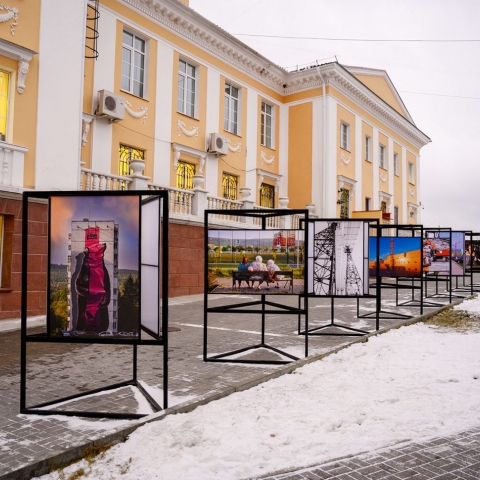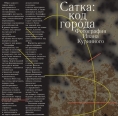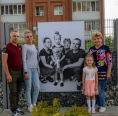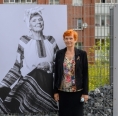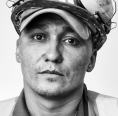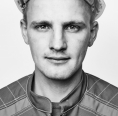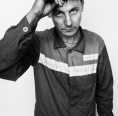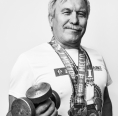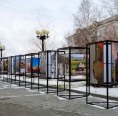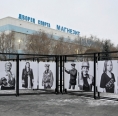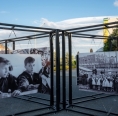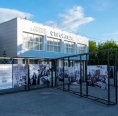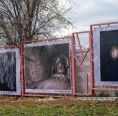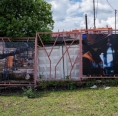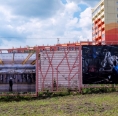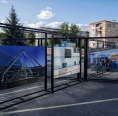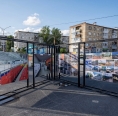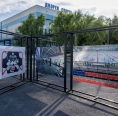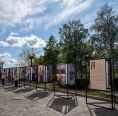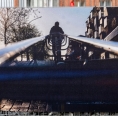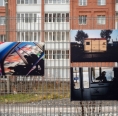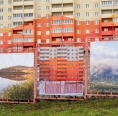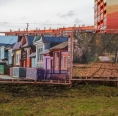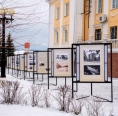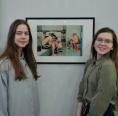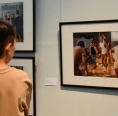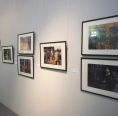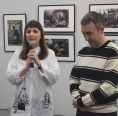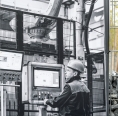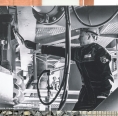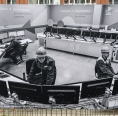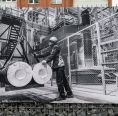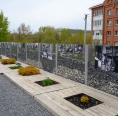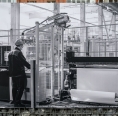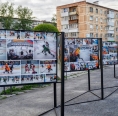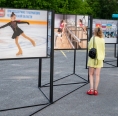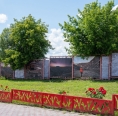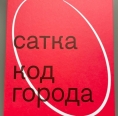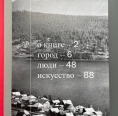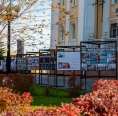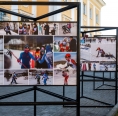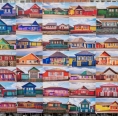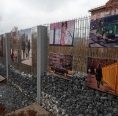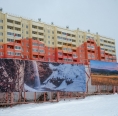-
“SATKA: CITY CODE”
A CYCLE OF PHOTO EXHIBITIONS
-
Address:
-
Partners:
“Satka: City Code” Street Photo Exhibition Cycle has been held in Satka with the support from Magnezit Group, Sobranie Fund, and the Satka District Development Assistance Fund since 2021. The Cycle reveals the interrelations of industry and urban life, as well as the culture of Satka and its residents, fitting the photo stories into the integrated visual city landscape. The operating project exhibition spaces were on Proletarskaya Street, near the Magnezit and Stroitel Cultural Centers.
The first part of the project was a photo exhibition created by the Moscow photo artist Ivan Kurinnoy who presented a code of Satka through portraits of people: metallurgists, teachers, the old generation and young residents of the city. As it is in the people, according to the author, that the content and diversity of the present and the future of the city are reflected and read. It should be noted that the project receives abundant support and feedback, especially on the part of the participants.
Fyodor Telkov’s photo project called “Water and Metals” exhibited in July 2022 near the Magnezit Cultural Center is a new story about the development of the city, which is dynamically changing together with its residents, enterprises, streets, and houses, together with its successes, plans and hopes, together with the two “mining forces”: water and metal.
A photo exhibition dedicated to the history of education in Satka was organized near the Stroitel Cultural Center for the Knowledge Day. Archival photos showed that learning was an integral and essential part of life for Satka residents and their home city. Photo sketches from secondary school and university, group portraits, and other photo stories became time-depicting documents, which allowed us tracing the strive for the new knowledge through the epochs, which, in its turn, served the basis for the development of Satka and the Satkinskiy district. The photo exhibition was organized in cooperation with the Satka Museum of Local Lore.
In October 2022, a photo exhibition from the City Code Cycle was opened on Proletarskaya Street, which was dedicated to miners and the Magnezitovaya Mine. The new photo story was authored by photographers of Satka and Yekaterinburg: Denis Shakirov, Maria Kochergova, Sergey Poteryaev, and Roman Dusov. Every one of them has their own view, they highlight different key points. Every one of them has seen their own story and transformed it into a visual narrative.
2021
On July 16 the firts part of the project called "Satka: city code" of Moscow photographer Ivan Kurinniy has opened in "Ruina" art-space.
The project was implemented with the support of Magnezit Group, Sobranie Fund and the Satka District Administration.
From the portraits presented in the exhibition, the viewer is looked at by workers of the town-forming enterprise, veterans of labor, teachers, as well as representatives of the young generation. It seems that all of them are frozen in a moment, and just to say “cut!” and they will continue to move.
"In cartoons, there is a trick where a magician takes off his hat and his image changes instantly. It’s the same feeling I have with my portrait of Eugene Derevyannykh. When he takes off the helmet, he will be someone else", sharing the impressions Anna, the guest of the exhibition.
In the portrait of Vladislav Nizamov, many found similarities with American actor Johnny Depp. But, despite the presence or absence of similarity with celebrities, everyone who got into the lens of Ivan Kurinniy could feel themselves as “stars” without exception.
Natalia Karimova says with a smile “I was surprised to get an invitation from a famous photographer. I was worried, and I did not expect my photo to be one of the first to appear. It’s interesting to look at myself from outside, I even feel like a model”.
All portraits of Satka people are made in black and white, this technique makes it possible to better feel the emotions and meaning embedded in them. It also helped to balance the photos with each other, as they were taken in completely different places, with different lighting.
"Satka is the town of great cultural endeavors. When working on the project, Ivan and I looked for an answer to the questions: what Satka people look like, who they are, whether we can get an idea of the town by looking at the faces of those who live in it, work in it, for whom it is a home. A total of 150 portraits were taken. For the exhibition were chosen 21 photos. This just tells us of the start of a story that will become long-playing", says the curator of the exhibition Elizabeth Korzheva.
"I would call this project “Satka in faces”. I recall Solnechnaya Street, where many years ago we placed on banners portraits of cutting-edge workers of manufacture. With today’s project, that story is coming back. We are proud of people living in our territory", said Alexander Glazkov, Head of Satka District.
2021
Photo project “Satka: City Code” is now continued: to celebrate 95th anniversary of the Satka Region the square in front of Stroitel HoC houses an exhibition with portraits of Satka residents.
Up to now the major part of the exhibition is taken up by 20 photos of Moscow art photographer, Ivan Kurinniy, which have already been presented to the Satka residents earlier within the exhibitions in the Ruina Art Space and near the front entrance of the Magnezit HoC. Representatives of different generations and occupations look at the visitors from the large monochrome canvas: Magnezit workers, those occupied in fields of culture, education, small enterprise, the elderly and the young residing in the town. In the near future the exhibition will receive additional new portraits, in total more than 40 photos by Ivan Kurinniy are to be exhibited in the HoC square.
Let us recall that the project “Satka: City Code” started on July 16th of this year, and is implemented with support of the Magnezit Group, the Sobranie Fund and the Satka Region Administration. Ivan Kurinniy’s photo exhibition is the first step of the project, which is now being continued by other authors, including the locals. The lens captured not only people, but the town itself, its production facilities and culture, the beauty of its forests, mountain peaks and rivers, its rich history and modern technologies.
It shall be noted that the project receives abundant support and feedback, especially on the part of the participants. The protagonists in the portraits and their relatives and friends often inquired about what was to happen to their photos which were temporarily removed from the exhibition, as some of the exhibition facilities had to be used for other projects. We are glad to inform that the exhibition will be expanded, and new photos will appear not only near the Stroitel HoC, but also on the main streets of the town. Currently project development, as well as new venues for the exhibition, are under negotiation, and we will soon provide updates with the new details.
2021
A series of photos of the city life continues the traditions of the project “Satka: City Code”, which focuses on the people of Satka. The exposition includes works of local and guest authors of different genres: landscape, portrait, street photography and others.
To the second stage of the project, the exposition format has changed and expanded, apart from the portraits of the people of Satka in the central streets now it will be possible to see a more substantive map of the city life. This exposition offers a new way to address recognizable urban areas and people who can be met in there. The exhibition brings together visual notes from different photographers, masters and original authors who build unexpected parallels on the urban canvas.
Black and white photographs are accompanied by with bright colors associated with the appearance of Satka. This juxtaposition acquaints the viewer with fragments of the life and history of the area, as seen by photographers, and allows them to look at the city with different eyes, the eyes of observers who first visited Satka, or the authors, who know and love the city and its character well.
The photos were taken in recognizable places, which largely determine the popular image of the city, including Metallurgov Street, Karagayskiy Quarry, Prospekt Mira, the production site of Magnezit Group, 40 Let Pobedy Street and Slavy Square. Being composed of landscapes and plot sketches, the exposition presents the author's collective point of view on the life of well-known points of attraction. Each urban space has its own distinct character, its own history and destiny. They become platforms for long-awaited and daily meetings, places for recreation and work, thus forming complex interlacing of destinies and geographical coordinates on the map of Satka.
The geography of the space, its history and present are reflected in the faces of all those for whom Satka is sweet home. According to the idea of the project “Satka: City Code”, people, who live in the center of production and culture, forest peaks and South Ural rivers, rich history and new technologies, tell non-verbally about what the city lives today.
The pictures presented at the exhibition create a diverse, emotional, characteristic code of the native land.
The exhibition takes place in two places: at the Palace of Culture “Magnezit” and at the Palace of Culture “Stroitel”.
2022
The personal exhibition of the photo artist Fyodor Telkov opened in Satka. The new exposition is a continuation of the project cycle “City Code”.
The project “Water and Metals” of Fyodor Telkov is presented on the open area near Magnezit Cultural Center. This is one of the exhibitions specially prepared for the Metallurgist Day by the Sobranie Fund and the Foundation for Assistance to the Development of Satkinsky District with the support of Magnezit Group and the district administration. Its first viewers were participants of the festival “Carmen”. Looking at the photos was like looking through the windows. Some of them reveal the past, some offer to see the details of the present, some lead to questions, and all together they gradually reveal the idea of the photo artist. And it is connected with the most industrialized territory on the planet - the Urals.
“Most of the settlements here were built around factories and for factories... Between the mountains, a dam was built on the river, a pond was filled, and the force of the water drove the factory machinery. The way the factories were built gave rise to a special type of construction and settlement life. Factories were united into mining districts. Thus a special “mining civilization” took shape, where the castles were replaced by the factories, the population were the workers, and the rulers were the factory managers, representatives of the factory owners,” the statement of the exhibition says.
An attentive viewer will easily notice one detail that unites all the shots of the exhibition: the colored tints. And this is not just an artistic technique, it is a direct link to the legacy of Sergey Prokudin-Gorsky, who visited the Urals at the beginning of the 20th century as part of his expedition to the Russian Empire and made the first color photos of the still working mining factories.
“The personal exhibition of Fyodor Telkov continues the exhibition cycle “City Code”, which is being implemented in Satka for the second year, talks about the relationship of industrial environment, urban life and culture, building up photo stories in a single visual landscape of Satka,” the curator of the project and photo artist Sergey Poteryaev says. “We are going to continue this project together with Satka authors and the local history museum.” We plan to change expositions of the cycle once in three or five months.
To remind, the first part of the project was an exhibition of the Moscow photo artist Ivan Kurinnoy who presented a code of Satka through portraits of people: metallurgists, teachers, the old generation and young residents of the city. Because it is in people, according to the author, that the content and diversity of the present and the future of the city is reflected and read. Fyodor Telkov's photo project is a new story about the development of the city, which is dynamically changing together with its residents, enterprises, streets and houses, together with its successes, plans and hopes, together with the two “mining forces”: water and metal.
2022
City Code Exhibition Cycle continues with a new exposition created together with the Satka Museum of Local Lore. The history of education in Satka is represented in a series of photos at a square near the Stroitel Cultural Center.
Archival photos show that learning is an integral and essential part of life for Satka residents and their home city. Photo sketches from secondary school and university, group portraits, and other photo stories become time-depicting documents, which allow us tracing the strive for the new knowledge through the epochs, which, in its turn, serves the basis for the development of Satka and the Satkinskiy district.
Modern opportunities to get education, new information or additional skills expand constantly: our customary educational institutions are supplemented by the new public spaces in response to the needs of wide audience. Innovations in the sphere of education, lecture halls and master-classes open to the public, web resources, transforming libraries, museums, and other public spaces, creative and educational spaces, as well as modern literature and the increasing number of the published books change the learning process, making it more accessible and free.
One of the examples showing the described dynamics is the new SATKA.LAB project launched for Satka residents: in the beginning of September, Art-Satka Creative Public Space (Proletarskaya Street, 6) host a cycle of educational programs supported by the grant given by the Governor of the Chelyabinsk region. It includes fee-free lectures and master-classes in arts, literature, cinema, etc.
Natalya Bogdanyuk, Tatyana Maryaseva, Sergey Poteryayev, and Nadezhda Potekhina prepared the exhibition.
City Code Street Exhibition Cycle is held in Satka with the support from Magnezit Group, Sobranie Fund, and the Satkinskiy District Development Assistance Fund for the second year in a row. The Cycle reveals the interrelations of industry and urban life, as well as the culture of Satka and its residents, fitting the photo stories into the integrated visual city landscape. At present, the project expositions are open near the Magnezit and Stroitel Cultural Centers.
2022
A new photo exhibition City Code has opened on Proletarskaya Street. The display is dedicated to miners and the Magnezitovaya Mine.
The new photo story was authored by photographers of Satka and Yekaterinburg: Denis Shakirov, Maria Kochergova, Sergey Poteryaev, and Roman Dusov. Every one of them has their own view, their own angle. Every one of them has seen their own story and transformed it into a visual narrative.
In her photographs, Maria Kochergova, a specialist with Magnezit Group and an enthusiastic photographer, captured ongoing processes on planes of the Magnezitovaya Mine, at various levels, down to 340 meters deep underground.
“Following magnesite veins, people are building tunnels, which are then filled with industrial facilities, equipment and light, cutting through the darkness and making black spaces visible”, says the exhibition summary.
Roman Dusov continues the story as he documents the heroes of those changes – the workers of the Magnezitovaya Mine. The project supervisor Sergey Poteryaev remarks that Roman's photos show people as creators of the underground space, courageous professionals extracting important raw materials from rock.
Denis Shakirov is focused on ‘reclamation’ of the underground space as he immerses nature photos into the ‘inside” of an industrial facility. A series of photos by Sergey Poteryaev picks up from his project Anticipating the Landscape of several years ago, which was presented at an exhibition in the Ruin space. This time however, the photographer is looking not at the pit but at the work in the mine.
“The photographs of the exhibition City Code. A Day in Life of a Mine are just the tip of the iceberg of events and processes that take place underground in Satka”, Sergey says. – “The herculean task the miners perform is hard to overestimate and even harder to visualise. The photographers are presenting their view on the work in the depths of the earth as they try to tell their own stories of what they have seen. We will continue exploring the life of the city in all its manifestations. The mine is another puzzle piece in getting to know the code of Satka.”
FOR INFORMATION:
The exhibition was organized with support from Magnezit Group, the Magnezit Museum, and the Satka District Development Support Fund. Contributors to the display: Galina Golovko, Manager of the Magnezit Museum, Sergey Zharkov, Captain of Magnezitovaya Mine, and Sergey Poteryaev, Supervisor and photo artist.
The City Code Street Exhibition Cycle in Satka is in its second year, telling us about interrelations of the industrial environment and urban life and about culture by fitting photo stories into Satka’s integrated visual landscape. At present, there are operating project exhibition spaces on Proletarskaya Street, near the cultural centres Magnezit and the Stroitel.
2023
An exhibition “Magnezit in Detail”, which is represented in Proletarskaya street, is one more step in a series of street expositions “Satka: City Code”.
The photos in the exposition were made by Viktor Molodtsov, a young photographer from Moscow. He spent some days working at the Satka Production Site of Magnezit Group. As a result he made the project, which represents the city-forming company in a new way, which is made up of a number of details and presents Magnezit both for those, who have never been at the enterprise, and for its employees.
— The photographer managed to show Magnezit not only as an industrial facility, showing the complexity of labor and concentration of working people, but also as a facility for creative shooting, says the curator of the exhibition Diana Gurova. — He managed to show the beauty of industrial facilities, machines, and equipment. The lens of his camera turned robots into the aliens, which worked for the benefit of the human race. The artist found the original details in the most seemingly common objects and showed them from such angles that it becomes clear for spectators: a piece of art can be made out of each and every object.
The photos show Impulse Furnace Products Complex, Progress Unburned Products Complex, Record Solid Sintered Powder Complex, stowage facilities of Magnezitovaya mine, Karagaiskiy and Beryozovskiy open pits, Russian Magnezit viewing platform.
We remind that “Satka: City Code” Street Photo Exhibition Cycle has been held in Satka with the support from Magnezit Group, Sobranie Fund, the Satkinskiy District Development Support Fund, and the Municipal Administration since 2021. The operating project exhibition spaces were in Proletarskaya street, near the Magnezit and Stroitel Cultural Centers.
The project was launched with an exhibition made by Ivan Kurinniy, the Moscow photo artist, who represented the Satka code through the portraits of its residents. Later the cycle included the photo project “Water and Metals” made by Fyodor Telkov; an exhibition devoted to the history of education in the Satkinskiy district arranged together with the Satka Museum of Local Lore; a project devoted to miners and Magnezitovaya mine made by the photographers from Satka and Yekaterinburg — Denis Shakirov, Maria Kochergova, Sergey Poteryaev, and Roman Dusov.
OUR INFO:
Viktor Molodtsov (born in 1984 in Glazov, the Udmurt Republic) is a reporting photographer, he has been engaged in professional shooting since 2009. That year he graduated from the Russian New University, in 2014 — the Documentary Photo School DocDocDoc in St. Petersburg. A finalist of competition “A Point on the Map” (2016). Well experienced in shooting of large industrial facilities.
Source: Magnezitovets. Photo by: Vasily Maksimov
2023
Another exhibition of the photo project “Satka: City Code” has opened near Stroitel Cultural Center. It is dedicated to the major town event of 2023 – the opening of Satka Ice Arena that took place yesterday on July 18.
The exposition shows photographs by Denis Shakirov and Vasily Maksimov.
You will recall that construction of the ice arena started in 2021 at the initiative of Governor Aleksey Teksler and with financial support from Magnezit Group under a concession agreement between the Administration of Satkinskiy District and Sport-Invest, a development company. Vostokmetallurgmontazh was the general contractor of the project.
Total area of the ice arena is 4,200 sq. m. It meets the most modern requirements to the facilities of this kind. The size of ice field is according to the standards of Kontinental Hockey League – 60×30 meters. And the field size can be made smaller, depending on the type and level of competitions.
The fan stands will seat over 400 people.
Apart from the arena’s heart – the ice field – it has a whole complex of convenient services: several training halls (a gym, a choreography hall, a throwing practice hall), modern and comfortable changing rooms, a doctor’s office and a massage room, a coffee area. There is a small cozy public garden around the arena building. Art objects, contributed by students of Satka’s A. K. Savin Mining and Pottery Vocational College, are installed by the main entrance stairs. There is parking for cars and buses.
Satka Ice Arena will become a new center of attraction in the town and will host competitions of the highest level. This will definitely help promote hockey and will reveal new opportunities – the town will have a figure skating class the townsfolk have long been dreaming about.
FACTS AND NUMBERS:
Satka’s first hockey boxes date back to 1951. One was on Metallurg stadium, another – on Magnezit factory stadium.
In 1957, a new hockey complex with fan stands, a training rink, a room for teams and referees was built in the new part of the town.
Magnezit’s hockey team, known as Trud in 1972–1985, won multiple prizes and first places among the teams of the second group of regional championship, and also came second in the first regional workers winter spartakiada of 1988 in the first group.
Now over 250 children and 100 adults play hockey in Satkinskiy District. Apart from professional sports teams, there are plenty of combined amateur teams, hundreds of avid hockey fans, and thousands of boys, girls, and older folk who love ice skating.
2023
A new project to continue the cycle of photo exhibitions “Satka: City Code” is presented at the space near Magnezit Cultural Center. The exposition is devoted to one of the oldest educational institutions in the city – the Satka College of Mining and Ceramics Named After A. K. Savin.
Today, it is the main institution of secondary vocational education in the city and the basic institution for Magnezit Group. The College offers courses in various areas: underground mining; production of churlish non-metal and silicate materials and articles; operation and maintenance of electric and electric-mechanical equipment; information systems and programming; pre-school education; teaching at elementary school; cooking and confectionery, etc.
Photos tell the story of formation and development of the institution. Fateful moments are shown there – student initiation ceremony, classes, educational and sport achievements of different times. Directors, teachers, and graduates look at us from the black and white shots made in the past century, and modern color photographs transfer us to the present.
A special place in the exposition is occupied by a portrait of a legendary man, who played a great role not only in the life of the college, but also for the Satkinskiy district — Anisim Konstantinovich Savin. His job history is interconnected with Magnezit, and since 1957 – with the vocational education system of Satka. In 1966, he was appointed a director of City Vocational Training College No. 69, he held this position for more than 40 years. Under his direction, a training base of the institution was improved considerably, a new building was constructed, a sport hall, a training workshop, and a dormitory were reconstructed; educational procedures were computerized, and other improvements were introduced. As a result, the college became one of the best educational institutions in the Chelyabinsk region. In 2009, it was assigned the name of Anisim Konstantinovich Savin.
Despite all the renamings and reorganizations, now the Satka College of Mining and Ceramics preserved the name of this unique Teacher and Man. This year, a book “The Sunny Man” about him was published in his memory. It is a collection of stories told by his relatives, friends, students, and colleagues. Those, who were on intimate terms and loved Anisim Konstantinovich, gratefully mention his limitless kindness, generosity, limitless love for people, and his invaluable contribution to development of the college and the city. He was enthusiastic about his work and believed that no matter how many difficulties a child faced or how many bad breaks they caught, everything can be put right, and only kindness, confidence, and sincere affection can grow up a real man.
Photos from the archives of the Satka College of Mining and Ceramics Named After A. K. Savin are presented at the exhibition, and the modern part of the exposition contains the photos made by photographer Egor Lazurenko.
OUR INFO:
First vocational educational institutions appear in Satka in the 1920s. So, in 1923, a factory apprenticeship school was founded on the basis of Magnezit plant. It provided training in the following specialties: locksmith, turner, and metalsmith-electrician.
In 1944, under the order issued by the people’s commissar of the State Defense Committee, the Satka College of Mining and Ceramics was founded as the main vocational institution, which trained specialists for Magnezit Plant, to improve personnel reserves for the fire-proof industry.
In 1946, Factory Apprenticeship School No. 54 was founded in Satka. Schools of this type were founded throughout the country on the basis of industrial enterprises and construction organizations within the system of State Labor Reserves of the USSR. Their main purpose was to prepare specialists for coal, metallurgical, and other industries. Gradually, School No. 54 became bigger, enlarging the number of specialties, and with due time it turned into the Satka Polytechnic College Named After A. K. Savin.
In the beginning of 2021, both colleges were merged; in the middle of 2021, the new institution was assigned its modern name: the Satka College of Mining and Ceramics Named After A. K. Savin.
2023
New expositions in the series of city street exhibitions are devoted to 265th anniversary of Satka and will be displayed in several open spaces at once.
Exhibition projects represented by the exposition “My Satka. City in Focus of Satka’s Photographers” displayed in Proletarskaya street, and at Ruina art-space where one can see new works of the Moscow photographer Viktor Molodtsov, are one more step in “Satka: City Code” Project. Within the next few days, the exhibition near the Magnezit Cultural Center will change – the new one will be devoted to the topic “City and People”. We will give information about this exhibition specifically and today we suggest to find out how Satka inspires different photographers and what tapestry of impressions they got and shared with viewers.
“Sun City” exhibition is a present made by the photographer Viktor Molodtsov to 265th anniversary of Satka. You may remember that he worked in our city in May of this year making a photo-project “Magnezit in Detail” (the exhibition in question was represented in Proletarskaya street). That was also when Viktor acquainted himself with Vyatka walking around the city streets and memorizing his impressions through the camera. One may have a look at these impressions at Ruina art-space. We are sure that the viewer will immediately realize why the exposition is called “Sun City” and will find out what moments and colors have been treasured by our city in the memory of our guest.
“The majority of represented photos were being made during several years and some of them have been made specifically for the exhibition. The city does not stay in one place, it is making progress and changing all the time. Sometimes, we simply do not manage to notice this, but, thanks to creative vision and painstaking work of Denis Shakirov, Denis Khabibullin, and Anton Bogachev, the history will keep the images valuable to us”: these are the words about the works of our countrymen taken from the summary to the exhibition “My Satka. City in Focus of Satka’s Photographers”. It is no coincidence that the exhibition name has preposition “my” in the first part since every city dweller has his/her own Satka. It is no coincidence either that this part evokes direct association with the same-name festival having given fresh impetus to city changes implemented by both Satka’s dwellers and guests thereof. The exhibition represented in Proletarskaya street combined classical, journalist, and avant-garde photos, as well as creative experiments carried out by the photographers inspired by the beloved city.
***
“Satka: City Code” street photo exhibition cycle has been held in Satka since 2021 with the support from Magnezit Group, Sobranie Fund, Satka District Development Assistance Fund. The Project exhibition spaces are in Proletarskaya street, in areas near the Magnezit and Stroitel Cultural Centers and at Ruina art-space.
2023
Another exposition presented as part of the cycle of street exhibitions “Satka: City Code” opened near the “Magnezit” Cultural Center. It is dedicated to the city, which recently celebrated its 265th anniversary, and its residents.
The new exposition consists of several parts. One of them presents photos from the archive of the Satka Museum of Local Lore. This is an invitation to the recent past: the pictures will remind what the city was like a few decades ago, how it changed and developed.
“Every settlement, whether it is a large city or a small village, is famous not only for its history, architecture and unique events, but also, of course, for its people. After all, each person creates—builds, equips and improves—the place of their residence. Creative labor gives the urban life a special atmosphere, imbues it with knowledge, experience, feelings—those features that fill the life around us and can be called the soul of the city, says the exhibition summary. “The soul of Satka is the heroic people who live here; people who have gone through many trials, hardships, who were able to stand, worked for the benefit of the city, built it, improved the infrastructure, shared their knowledge, created works of art, literature, and achieved high sports awards. These people heal and educate, protect and improve the environment, keep order; these are the people who contributed to the development and prosperity of the city. They have lived here all their lives or part of it. Some spent their youth and adolescence in Satka—periods when a human personality is being formed—and some came here as an adult and fell in love with this city, serving it with their skills. It is to these residents that the “City and People project is dedicated.””
The next part of the exposition is stories. Aleksandr Ivanovich Saburov, a Magnezit employee and a representative of a large labor dynasty. Rimma Dyshalenkova, a remarkable poetess who spent her youth in Satka and kept her love for it throughout her life. Also, four Satka-born schoolgirls—a team of young skiers who won the All-Union competition for the prize of the “Pionerskaya Pravda” newspaper in competitive cross-country skiing in Khanty-Mansiysk in 1984. By the way, the story of the photo dedicated to this event and presented at the exhibition is also interesting. But more of that later—in our next publications.
2024
The photo exhibition “There Are a Lot of Different Professions” from the series “Satka: City Code” has opened on March 27 in the Magnezit Cultural Center. It is the project's first exhibition set up inside the palace rather than outdoors.
The author of the idea designed to remind how versatile professional life can be and tell a story about people creating the modern world is Diana Gurova, the supervisor of the project Satka: City Code.
“Last year, I was introduced to Oleg Panov and Vera Panova, who were recommended to me as talented photographers. When I saw the work they produced for a whole range of projects and I thought that we had to do a project together. I wanted to do something special to show how subtle Vera and Oleg are in their perception of things they take photos of. That made me think of an exhibition that would portray professions that have been “forgotten” or lost their popularity, while in fact we can't exist without them,” Diana said. The result has exceeded all expectations. There is lightness, spontaneity and humor about these photographs, but they also show the focus on work. It’s just not possible to say which photos are the best. And the project will continue, quite soon. But we’ll talk about that later.
The exhibition has turned out to be really interesting. The photos show a street cleaner, a janitor, a cloakroom attendant, a cook, doctors as well as nurses and their patients (just like in the last of our selected photos), people that work in education, culture, sports… There is a photo of a blacksmith creating genuine works of art out of forge iron. Another one shows an artist, who draws posters by hand in our age of computers and professional printing houses. There is a separate series of photos dedicated to women working for a “mechanical repair company” as an electrician repairing coils and insulation of electrical equipment, a lab assistant in an electromechnical testing and measurements laboratory, an insulation worker, a turner, and a crane operator.
The visitors have pointed out that the only thing missing at the exhibition is photos of the photographers at work.
“This is our first joint project with Vera. We accepted the proposal to take part in the project with enthusiasm. We took about a hundred photos overall. Fifty were selected for the exhibition. Admittedly, it was a very hard to do. By the way, there a QR code in the description of the exhibition, which can be used to see the photos that were not selected,” Oleg Panov says.
“We’ve gained interesting experience in this project. It’s not every day that you get the chance to visit Mangezit divisions and observe the atmosphere at the production facility. We were trying not to disrupt the work process. Nothing you can see on the photos was staged. These people were doing their job and we were doing ours. We are grateful to the management and specialists of the enterprise for meeting us halfway and helping us organize the photo shoot process,” his wife (Vera) added as she announced the theme of the next exhibition the couple are working on.
Among the first-day visitors to the photo exhibition There are a Lot of Different Professions, there were the actual heroes of the photographs as well as their families, friends and acquaintances, so there was a lively dialogue going on or people taking photos around every exhibit.
“When they asked me if I could take part in a photo project as a subject, I declined. I just did not expect such a thing and got confused. But then I thought about it and accepted the offer. And I haven't come to regret it. The project has worked out well. The photos convey the atmosphere of a school break very accurately. The exhibition is most interesting as a whole as well,” opined Rushania Mukhamedyarova, whose caring hands make School No. 5 clean and tidy.
2024
Magnezit employees again became characters of the “Satka: City Code” project. A new exhibition was opened at Ruina art-space near the Magnezit Cultural Center; it continued the photo story “There Are a Lot of Different Professions” told by Oleg Panov and Oksana Panova.
“Magnezit. “Unexplored” Professions” is the first street project launched this year that is represented within a series of exhibitions, which tell us about the life of Satka and the professions at the Satka’s backbone company – Magnezit Group.
“For many years the city life has been connected with the mining of magnesite and production of materials on its basis. In Satka, magnesite mining was started back in 1900, and in a year the production of refractory products was launched. The company development is considered successful; now it undergoes an overwhelming process improvement; time of innovations is the time for new specialists and professions. Many of them can yet be called “unexplored”, as they are not so well-known outside the production sites, says an exhibition abstract. Its authors pose a question together with Diana Gurova, the project curator: do many people know anything about the functions of instrument or measurement technicians or an engineer of a material engineering laboratory? About such professions as a process operator or a melting operator, a sorting operator of semi-finished and finished products and a lot of other specialties, which change and develop together with Magnezit Group?
The main task of the photographers Oleg Panov and Vera Panova was to tell about these “unexplored” professions. For some days they observed the work of the Magnezit employees in various subdivisions of the company and presented the results of their trip to “the unexplored” in the black-and-white. Why? The answer is simple: it is an artistic technique that will help a spectator:
- Black-and-white photos, which remind of graphic sketches, help a spectator focus their attention on the characters depicted in the photos and the processes, into which they are involved, feel how the employees are concentrated on their activities to carry out their work in a good quality, at a high level of worldwide standards, Diana Gurova notes.
We are glad to invite you to the new exhibition (it will be open until October) and remind you that the first part of the project implemented by the Panovs – the exposition “There Are a Lot of Different Professions” – is exhibited in the Magnezit Cultural Center until May 20.
2024
On July 18, a year to the day passed since the opening of Satka Ice Arena – a wonderful reason for the new events, which were organized with the assistance of Magnezit Group.
For this year, the ice arena was attended by more than 32,000 visitors. It hosted a lot of regional competitions, including the events, which were held in Satka and the Satka district for the first time. For example, big sports holidays: “Ice and Flame 2024” and “Curling Day”. Large-scale hockey competitions: the XХII Sports and Athletic Contest of Secondary School Students of the Chelyabinsk Region “Olympic Hopes of South Ural 2024”, final of the regional ice hockey championship of boys, games of the XIII All-Russian Amateur Hockey Festival, a regional stage of “Golden Disk”, one of the most popular hockey tournaments in Russia, etc.
The new photo project called “Ice Arena. Forward! Reach New Heights!” shows also other events conducted in the new sports complex, how the new ice arena changed the lives of our countrymen, the new opportunities for sport fans. Its author is photographer from Satka Vasily Maksimov. Bright, dynamic and emotional as the sport itself, the exposition opened in the square by Stroitel Cultural Center, it continues a series of street exhibitions: “Satka: City Code”.
“Almost a year Vasily observed the lives of sportsmen, fans, trainers, technical assistants of the ice arena and captured the enthusiasm of victory and bitterness of defeat, first children’s skating and joy of young hockey players after the first success, pain of injuries and a strong wish not to give up, emotions of spectators, worries of parents, and the main thing – the real ethos of sport, which fills every photo”, notes Diana Gurova, the exhibition curator.
It is quite a complicated task to select the most impressive moments for the exhibition from hundreds of photos; they are made in two different formats. On one side of the stands a visitor sees a real kaleidoscope made of photographic reports. On the other side – sport and related emotions are presented in close up.
And the new big event will take place in the arena in coming days. It will be devoted to the first anniversary of the sport complex and, of course, become one more present for the residents and guests of Satka. On July 20, the players of the Tractor hockey club Sergey Telegin and Ilya Nikholayev will conduct master classes for the children from our district and other municipal districts of the mining and metallurgical area (start at 1 p.m.). Before the meeting with the professional players, the children will have an opportunity to show themselves on ice: an ice hockey tournament of the children’s teams from the mining and metallurgical area will start the holiday (start at 10:30 a.m.). Admission is free.
Let us remind you that the motto of the ice arena is “Forward! Reach New Heights!”. This year, more than one height was reached here, and the new sport achievements will wait for us in the future. We wish the team, all sportsmen and their trainers and spectators success in achievement of goals, big and small victories, valuable lessons and experience in advancement, joyful and happy moments generously given by sport and healthy lifestyle! Congratulations!
OUR INFO:
The grand opening of the ice arena took place on July 18, 2023. The celebration was attended by Governor of Chelyabinsk Region Aleksey Teksler, Chief Officer of Magnezit Group Sergey Korostelev, three-times world champion, silver and bronze medalist of the Olympics, Head Coach of CSKA Sergey Fyodorov, and People’s Artist of the Russian Federation, winner of the State Prize of the Russian Federation, musician Igor Butman. Guests of honor included labor veterans and employees of Magnezit Group.
Construction of the ice arena started in 2021 at the initiative of Governor Aleksey Teksler. The project received financial support from Magnezit Group under a concession agreement between the Administration of Satka District and Sport-Invest, a development company.
Sergey Telegin: defense man of the Tractor hockey club, bronze medalist of the Kharlamov Cup (2019), the best new player of the ninth week of Kontinental Hockey League (2020), the best defense man of the ninth week of Kontinental Hockey League (2022), silver medalist of the Olympics (2022), bronze medalist of the Kontinental Hockey League championship (2022, 2024).
Ilya Nikholayev: defense man of the Tractor hockey club, silver medalist of the Gagarin Cup (2022), bronze medalist of the Kontinental Hockey League championship (2024).
2024
In the center of Satka, in Proletarskaya street, a new exhibition is presented in a series of street projects called “Satka: City Code”. It is devoted to Karagayskiy Quarry, which will celebrate its 125th anniversary next year; it is named in quite an intriguing way: “Karagayskiy Quarry. Flight to Mars”.
A part of the exposition with old black and white photos from the archive of the Magnezit Museum reminds us of how magnesite was mined in the past and even recently, how the technologies and the facility itself changed and developed. It is noted in the annotation to the exhibition that for almost 125 years Karagayskiy Quarry has turned into a vast mine opening: deep and wide, with its own processes inside, connected directly to the mine and tunnels to the interior of the Earth, multiple roads and railways used for transportation of mined ore. Due to its beauty, it became one of the main sightseeing attractions of Satka. Specially for excursions, a safe view point with an impressive all-round view was built on one side of the quarry.
“Often industrial objects become a source for creative inspiration. So, Karagayskiy Quarry became an attraction point for many artists and photographers, some of them crossed the borders of ordinary and practical understanding of its essence and let their imagination run free”, says Diana Gurova, the project curator. “Young talented photographer from Krasnoyarsk Roman Yakovlev was specially invited to Satka. He spent some days in a quarry, enjoying sunsets and sunrises. Soft beams of warm sun and non-standard approach to shooting let him turn familiar views of Karagayskiy Quarry into Martian landscapes – as we could imagine them. Combination of sienna tones – from gold to deep red – supplemented by cold tones of unmelted snow, vehicles that seem to move by themselves and, of course, its ‘residents’, who make the quarry function – all these form a feeling of irreality, being on ‘another planet’.”
This effect is amplified by the scale of the photos. Black and white design emphasizes the artistry of the photos made by Roman and focuses attention on textures – peculiarities of rocks.
“Mars is a faraway planet, studying it for many years, the mankind strives for it”, it is mentioned in the annotation to the exhibition. “But it is still not accessible for us. Karagayskiy Quarry is a ‘planet’ on the Earth. One can admire it from a distance, but nobody can take part in its life without special training and skills. It has been studied since its opening, but nobody knows how many secrets it still keeps…”
We invite you to have a look at the “planet” on the Earth. The exhibition organized with the assistance of Magnezit Group, Sobranie Fund and the Satka District Development Assistance Fund, will be open until the middle of October.
2024
Libraries and museums of the city received the new edition of the book “Satka: City Code”.
This editorial project continued another public project: a cycle of street exhibitions “Satka: City Code”. This is not just only a review of the implemented ideas, but also a research of Satka, which has acquired its bright individual features, especially, over the last 10 years. Where does it express itself? In the nature, architecture, its residents or art? In the opinion of the authors of the book, the answer to this question is being looked for since 2021, when the project “Satka: City Code” was launched, by its organizers, curators and photographers. The readers of the new book are also offered to immerse into that attractive process of searching for the answer to the question: what is the code of the city of Satka?
The book consists of three parts: “City”, “People” and “Art”. It is structured in an unusual way: sometimes makeup seems to repeat the city space, now strictly adhering to the structure of pages, as if the houses were arranged along the main streets, and then being more free and natural, as if in a cozy yard within a residential area, it seems to repeat the main idea of the book, focusing our attention on bright accents, such as city art objects… This is achieved due to a great many of illustrations, both archival documents and photos from the funds of the Magnezit museum and the Satka Museum of Local Lore and modern shots made by photographers, who took part in the project, as well as photos from the archives of Sobranie Fund.
“In the book, we tried to show Satka from different perspectives based on its environment, residents of the city and art”, writes Ilya Pronchenko, the author of the texts. "But it is also important to emphasize the line, which unites them. Art as interaction, the enterprise as the catalyst for changes and the place for innovations, individual stories of people, past, present and future — that’s what made the place as we see it now. Satka became a bright example of a small city of the 21st century with the level of environment that can be compared with metropolises; it became a city that lives in harmony with nature and is appreciated by its residents; the city that develops dynamically. Who knows, maybe it is what we call Genius loci — spirit of the place?”
The book was published at the initiative of Sobranie Fund, with the support from the Satka District Development Assistance Fund and Magnezit Group. The edition is quite small: 1000 copies. A part has already been provided to the Magnezit Museum, the central library system of the city and the Museum of Local Lore. The new book will also be presented in the unique library of Art-Satka creative public space.
BY THE WAY
Here we offer some quotations from the book, let they be a stimulus for the potential readers to study the book more thoroughly:
“All these codes — architecture, art, lifestyle peculiarities, industrial landscapes, nature and people of course — form a unified picture, which shows us that this place differs from the others.”
“In many aspects, the photos in the book fixed the changes that happened to Satka within the last 20 years. This publication — as well as photo projects — is a link in a long lasting chain of events in the process of Satka transformation. One can say that the “cultural revolution” of the city is recorded. In the texts within the sections we analyze the city code, reveal the “city — people — art” link, with its parts in a close contact.
“The city is an experiment, dynamics and dialog with its residents. It is interesting here to look not only at the past and the present, but also at the future. The way how Satka changed: how has the settlement built in an irregular way with wooden houses turned into the city we have now? We will try to trace this development in the future.”
“… the enterprise is not only the place where the products are manufactured, but also the main catalyst for changes in the city, an important attraction point that can be studied now thanks to the industrial tourism programs.”
“It can be said that many objects created by humans repeat natural forms: the Magnezitovaya Mine looks like sinkholes of Sikiyaz-Tamak, ledges of the Karagayskiy Quarry “rhyme” with Aiskiye Prityosy rocks.”
“The city functions as an “organism”, it has a “carcass” (general plan, design, utilities and arrangement, street planning), “tissues” (multi-storeyed dwelling houses), “plasma” (murals, “Little Prince” square). It can be studied layer by layer, district by district, object by object.
“All people in Satka are different, but there is an impressive idea that unites them. This is the idea of joint responsibility for their home and engagement and that everyone will find their place here. It can be said that Satka is an example of a city of the 21st century, where something always happens, where senses and opportunities are generated, which form the identity of the residents.”
2024
A new exhibition from the ‘Satka: City Code’ series is devoted to the V. I. Gundartsev Sports School. The exhibition features over 250 modern and archival photographs, telling the sports story of a famous local figure and his followers.
A part of the exhibition is dedicated to Vladimir Ilyich Gundartsev, a biathlete, winner and medalist of numerous sports competitions, whose most significant award was the gold medal in the biathlon relay at the 10th Olympic Games in Grenoble, France, in 1968.
“Vladimir Ilyich has become a hero for multiple generations in our country and a role model for young athletes”, says Diana Gurova, the exhibition curator. “We found it very important to remind the citizens of Satka and the guests of the town about the history of this remarkable person during the anniversary year of the school named after him. We will highlight the most interesting and significant moments from his biography and sports career, and of course, remind everyone of that Olympic success—the globally renowned event of 1968—when the gold medal in the biathlon relay at the 10th Olympic Games was won by the USSR team, of which Vladimir Ilyich was a part. This breakthrough marked the beginning of a 20-year period of victories for our athletes in this type of competition at the Olympics. Exactly 50 years ago, in 1974, a decision was made to open a youth sports school in Satka, which has proudly borne the name of Vladimir Ilyich Gundartsev for the past 10 years.”
The exhibition features not only archival photographs provided by the V. I. Gundartsev Sports School, but also contemporary reportage images by Vasily Maksimov, a photographer from Satka. He worked on the project for over 3 months and gathered a vast array of sports emotions. The viewer, along with the athletes in his photographs, will experience joy, the thrill of speed, concentration, tension, fatigue, and a multitude of other emotions that accompany the journey to sports victories.
Initially, the school was located on the first floor of a building constructed in 1937, while the second floor was designated for the Youth Center. In 2000, with the support of Magnezit, a large-scale reconstruction of the building began. In 2001, an air-supported structure with tennis courts was opened, becoming the third facility of its kind in Russia at that time. Following the renovation, new halls for various sports and new sports clubs were established.
Nowadays, the sports facility is open not only to skiers and tennis players. It also offers classes in rhythmic gymnastics and powerlifting, as well as access to a gym and chess lessons. Most recently, in 2023, a football section was established
Currently, about 700 children of various ages are enrolled in the school, with clubs available for adults as well. More than 20 coaches provide athletic training for the younger generation.
Which names are associated with the school’s successes? Who has dedicated many years to coaching and continues to contribute to the physical development of the younger generation? Whose names have resonated at All-Union competitions and continue to be heard at All-Russian competitions, as well as at World and European championships? What unites the school’s students and their coaches? You can find the answers in the new exhibition. It is open at the venue near the Magnezit Palace of Culture and will run until March 8, 2025.
By the way, on October 30, the sports school plans to celebrate its anniversary. The celebration will take place at the Magnezit Palace of Culture.
2024
A new project of the street exhibition cycle Satka: City Code is presented in the Ruina art space near the Magnezit Cultural Center. The project is dedicated to the forthcoming City Day, which is November 19.
The author of the project is Roman Yakovlev, a young photographer from Krasnoyarsk, whose work became known to Satka residents and visitors through the “space” project The Karagaiskiy Quarry. A Flight to Mars, displayed on Proletarskaya Street.
“Like many guests in our city, Roman loved the place with all of his heart. “Satka is a very cool city!” he believes, and these words of the photographer became the name of a new street exhibition,” says Diana Gurova, the project supervisor. “In contrast to when he was working on the Karagaiskiy Quarry exhibition, Roman didn’t have any specific objective or goal as he was taking photographs of the city. The project was developing spontaneously, from the artist’s impressions and emotions brought to him by Satka. Every one of his photographs is an atmosphere snapshot filled with sincerity and love and reflecting various feelings that he had as he walked around the city.”
Diana noticed that the guest from Krasnoyarsk was able to see various aspects of our city and convey the romantic and the mysterious about it in his landscape photos.
“The atmosphere in the images with the old timber houses is quite different – they reflect a riot of the brightest colours, which are good to see in any weather. The apotheosis of the series of photos of the old Satka was the collage, which seems to include hundreds of tiny houses from Russian folk tales,” the project supervisor continues. “In Roman’s photos, you can see the stories of people caught on camera, be it accidentally or not. All of them are focused on what they are doing. Someone is cleaning or repairing their beloved car, someone is riding a bicycle or crossing a street on a crosswalk The Beatles style (a shot inspired by the iconic photo by Iain Macmillan, which subsequently became the cover for the Beatles’ album Abbey Road), someone is out with their kids, and someone is being taken out for a walk by their beloved dog. Roman’s photos show animals and vehicles as full residents of Satka. Subtle humour and the aesthetics of color and photo frame run through all of these works.
An attentive viewer will notice a characteristic thing about the photos, which is the combination of deep and hushed colors: pink, green, yellow, blue, red, as well as various shades or brown and grey. Their contrast, according to the project supervisor, is enhancing the complexity of the city, its energy; this contrast is a powerful tool to convey the moods flowing around inside the city, and its inner and outer beauty. All those feelings and emotions are present at once in the photographs with the rainbow. A rainbow is the energy of love that envelops Satka with an arch, which is like kind and loving arms protecting the city from dark clouds and woes.
2024
"Native Landscapes"- this is the name of an exhibition project made by Denis Khabibullin, a photographer from Satka, represented within the “Satka: City Code” cycle of street exhibitions displayed in Proletarskaya Street.
The exhibition immediately attracts attention due to vast panoramic photos (8х2 meters each - such a format is used in a street exposition for the first time!) and, of course, the natural beauty of our region depicted on them.
- Denis likes to take long bicycle walks to see the native landscapes. Each time he takes his photo camera with him to catch unique moments of beauty around us. As each moment the sights look different depending on the day and year time and weather,” says Diana Gurova, the project supervisor. – These photos show us Zyuratkul lake — the most highland one in our region — from a bird’s eye view. It is popular not only due to its picturesque shores, but also due to the unique properties of its water that make the lake the main source for water supply in Satka. There are also some of the most grandiose ridges in the South Ural — Nurgush, Uvan, Zyuratkul covered with impassible forest — on the photos. Golaya hill — a giant mountain top almost without any plants on it — stands out against their background.
One of the worth mentioning places around Satka is the Aisky cliffs. One of the most miraculous places here is the Dry waterfalls or the Alekseyevsky narrow, where Denis managed to take a photo of a unique phenomenon – awakening of a “dry” waterfall. It revives only for some days: in spring, when intense snow melting starts, and after heavy rains, when water streams get to the river bed of an ancient dried-up river. Witnessing it is a great luck.
– A sun-drenched birch grove near Mezhevoy settlement, sanctuaries of the Zyuratkul National Park, azure “caught” in a ring of a flooded quarry and a golden mirror of the Satka city pond in the evening — all of them attract our attention. When we look at them, we want to take a walk, forget about the daily life and contemplate the spiritual issues that fill our souls and make us happier,” says Diana. – Photos made by Denis remind us that the main richness of our region is our unique nature, the gift of life itself. We should not forget that it is very fragile, that human activities can inflict irreparable damage, that we should love our home area and take care of it!
-
2025
Lecture series on art
-
2012
The Russian Museum. Satka
-
2019
MAMM

